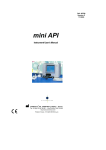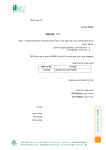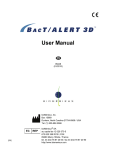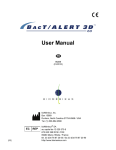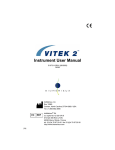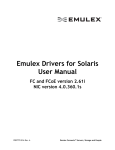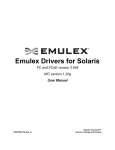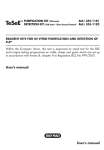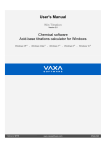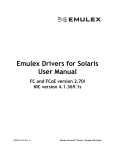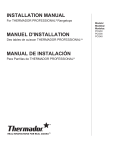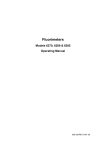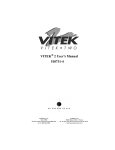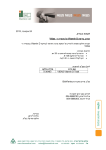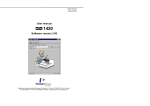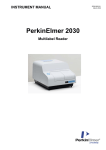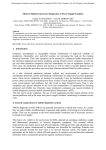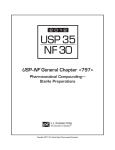Download Biomerieux Vidas - User manual
Transcript
Ref : 99762 Version B 12/2005 VIDAS® Instrument User’s Manual bioMérieux® SA 69280 Marcy l'Etoile / France Tel. 33 (0)4 78 87 20 00 - Fax 33 (0)4 78 87 20 90 http://www.biomerieux.com Printed in France / 673 620 399 RCS Lyon © 2005. bioMerieux, SA V. AG 06.2005 en Argentina bioMérieux Argentina Av. Congreso 1745 (C1428BUE) Capital Federal Buenos Aires tel. (54) 11 5555-6800 fax (54) 11 5555-6888 Colombia bioMérieux Colombia Ltda Avenida 15 No. 100-43 Piso 2 Bogotá D.C. tel. (57) 1 520 0080 fax (57) 1 520 0088 / 1 520 0831 Australia bioMérieux Australia P/L Unit 25, Parkview Business Center 1 Maitland Place Baulkham Hills NSW 2153 tel. (61) 2 8852 4700 fax (61) 2 8852 4777 Denmark bioMérieux Danmark Aps Smedeholm 13C, 2730 Herlev tel. (45) 70 10 84 00 fax (45) 70 10 84 01 Austria bioMérieux Austria GmbH Eduard-Kittenberger-Gasse 97 Top 3 A-1230 Wien tel. (43) 186 50 650 fax (43) 186 50 661 Belgium bioMérieux Benelux s.a./n.v. Media Square 18-19 Place des Carabiniers Bruxelles 1030 tel. (32) 2 743 01 70 fax (32) 2 733 55 97 Brazil bioMérieux Brasil SA Estrada Do Mapua 491 Taquara - Jacarepaguá CEP 22710 261 Rio de Janeiro R.J Rio de Janeiro R.J tel. (55) 21 2444 1400 fax (55) 21 2455 6025 Canada bioMérieux Canada, Inc. 7815, Henri-Bourassa West Saint Laurent, QC H4S 1P7 tel. (1) 514 336 7321 fax (1) 514 807 0015 Chile bioMérieux Chile S.A. Seminario 131 Providencia Santiago tel. (56) 2634 20 92 fax (56) 2634 20 93 China bioMérieux China Limited 17/Floor, Yen Sheng Centre, 64 Hoi Yuen Road, Kwun Tong Kowloon - Hong Kong tel. (852) 2356 7033 fax (852) 2330 2085 Finland bioMérieux Suomi Oy Rajatorpantie 41 C 01640 Vantaa tel. (358) 9 8545 6000 fax (358) 9 8545 6045 France bioMérieux SA 69280 Marcy l’Etoile tel. 33 (0)4 78 87 20 00 fax 33 (0)4 78 87 20 90 http://www.biomerieux.com Germany bioMérieux Deutschland GmbH Weberstrasse 8 D-72622 Nürtingen tel. (49) 7022 30070 fax (49) 7022 36110 Greece bioMérieux Hellas S.A. Papanikoli 70 15232 Halandri Athens tel. (30) 210 81 72 400 fax (30) 210 68 00 880 Hungary Representation office bioMérieux B.V. Hungarian Reitter Ferenc u. 39-49 1135 Budapest, Budapest tel. (36) 1 412 3880 fax (36) 1 412 3890 India bioMérieux India Pvt. Ltd D-45, Defense Colony New Delhi 110 024 tel. (91) 11 2 464 88 40 fax (91) 11 2 464 88 30 Indonesia bioMérieux Asean Enseval Building Kawasan Industri Pulo Gadung - JI. Pulo Lentut No. 10 Jakarta Timur 13920 tel. (62) 21 461 51 11 fax (62) 21 460 41 07 Italy bioMérieux Italia S.p. A Via Fiume Bianco, 56 00144 Roma tel. (39) 06 52 308 1 fax (39) 06 52 308 240 Ivory Coast bioMérieux Afrique Occidentale 08 BP 2634 Abidjan 08 tel. (225) 22 40 93 93 / 22 40 41 40 fax (225) 22 40 93 94 Japan bioMérieux Japan, Ltd Seizan Bldg., 12-28 Kita-Ayoama 2-chome Minato-ku, Tokyo 107-0061 tel. (81) 3 5411 86 91 fax (81) 3 5411 86 90 Korea bioMérieux Korea Co., Ltd 7th Floor Yoosung Building # 830-67, Yoksam-dong, Kangnam ku Seoul tel. (82) 2 547 6262 fax (82) 2 547 6263 Mexico bioMérieux México SA de CV Chihuahua 88, col. Progreso México 01080, D.F. tel. (52) 55 5481 9550 fax (52) 55 5616 2245 Netherlands (The) bioMérieux Benelux BV Boseind 15 P.O. Box 23 5280 AA Boxtel tel. (31) 411 65 48 88 fax (31) 411 65 48 73 New Zealand bioMérieux New Zealand Ltd 22/10 Airbourne Road North Harbour Auckland tel. (64) 9 415 0601 fax (64) 9 415 0603 Norway bioMérieux Norge AS ∅kernveien 145 N - 0513 Oslo tel. (47) 23 37 55 50 fax (47) 23 37 55 51 Spain bioMérieux España S.A. Manual Tovar, 45-47 28034 Madrid tel. (34) 91 358 11 42 fax (34) 91 358 06 29 Turkey bioMérieux Diagnostik A.S. Değirmen Sok. Nida Plaza Kat:6 34742 Kozyataği / Istanbul tel. (90) 216 444 00 83 fax (90) 216 373 16 63 Philippines (The) Representation office bioMérieux Philippines Rep. Office 11th Floor, Pearlbank Centre 146 Valero Street, Salcedo Village 1227 Makati City tel. (632) 817 7741 fax (632) 812 0896 Sweden bioMérieux Sverige AB Hantverksvägen 15 436 33 Askim tel. (46) 31 68 84 90 fax (46) 31 68 48 48 United Kingdom bioMérieux UK Ltd Grafton Way, Basingstoke Hampshire RG22 6HY tel. (44) 1256 461881 fax (44) 1256 816863 Switzerland bioMérieux Suisse s.a. 51, avenue Blanc Case postale 2150 1211 Genève 2 tel. (41) 22 906 57 60 fax (41) 22 906 57 42 USA bioMérieux, Inc. 100 Rodolphe Street Durham NC 27712 tel. (1) 919 620 20 00 fax (1) 919 620 22 11 Poland bioMérieux Polska Sp. Z.o.o. ul. Zeromskiego 17 01-882 Warszawa tel. (48) 22 569 85 00 fax (48) 22 569 85 54 Portugal bioMérieux Portugal, Lda. Rua Alto do Montijo, Lotes 1 e 2 - Portela de Carnaxide 2794-070 Carnaxide tel. (351) 21 424 59 80 fax (351) 21 418 32 67 Russia o.o.o. bioMérieux Petrovsko-Razoumovskii proyezd, 29 127287 Moscow tel. (7) 095 212 10 26 / 095 424 79 38 fax (7) 095 214 95 41 Taiwan Representation office bioMérieux China Limited - Taiwan Branch RM 608, No. 6-3 Ching Cheng Street Taipei 105 tel. (886) 2 2545 2250 fax (886) 2 2545 0959 Thaïland bioMérieux Thaïland Ltd Regent House Bldg, 16 th Floor 183 Rajdamri Road, Lumpini, Pathumwan Bangkok 10330 tel. (66) 2 651 98 00 fax (66) 2 651 98 01 Distribution in over 130 countries Vietnam Representation office bioMérieux Vietnam Rep. Office 17 Nguyen Van Mai, Ward 8 District 3 Ho Chi Minh City tel. (84) 88 299 599 fax (84) 88 207 898 V.B 02/2005 This manual is periodically updated. The updates shall be included in the new releases of the Software. Information supplied in this manual may be subject to modifications before the products described become available. This manual may contain information or references relating to certain bioMérieux® SA products, software or services which are not available in the country of release; this shall not mean that bioMérieux SA intends to market such products, software or services in such country To request copies of publications or for any technical request, contact bioMérieux SA or your local distributor. Liability disclaimer This manual is provided “AS IS” without any warranty, whether express or implied, of merchantability, safety, quality, accuracy, performance of products described on this manual, including an implied warranty of merchantability or fitness for a particular purpose, non infringement of third parties intellectual property rights and against an incidental or direct damage. In no event shall bioMérieux SA be liable for any direct or indirect damage or consequence related to, arising out of or in connection with, any use of this manual and/or its results by the User and/or any third party. In no event shall this manual be construed as an undertaking of bioMérieux SA, who reserves the right to modify this manual without notice and shall incur no liability as a result of such modification. This manual is provided for information purposes only and except for the present provisions does not constitute a binding document legally. Intellectual Property bioMérieux SA is the sole owner of copyright, patrimonial rights and any other intellectual property rights in and to this manual and its content subject to possible third parties rights. This manual and its content are protected under the provisions of section L.111-1 and following articles of the French Intellectual Property Code and International Copyright and Author Rights Treaties. The rights to use this manual granted herein are non-exclusive and limited to the extent necessary to use the Software and Instrument. In no event shall the Users be granted herein any other right to use this manual including without limitation, the right to reproduce, represent, adapt or translate all or part of this manual by any mean whatsoever and in any country without the prior written consent of bioMérieux SA. Any use of this manual other than expressly permitted hereunder shall be prosecuted. IMPORTANT! USE OF THIS MANUAL CONSTITUTES ACCEPTANCE OF THE CLAUSES ABOVE MENTIONED. bioMérieux, the blue logo and VIDAS are used, pending and/or registered trademarks belonging to bioMérieux SA or one of its subsidiaries. Windows is a used, pending and/or registered trademark belonging to Microsoft Corporation. Dacron is a used, pending and/or registered trademark belonging to Invista North America, SARL. 7X is a used, pending and/or registered trademark belonging to MP Biomedicals, LLC. Alconox and Liquinox are used, pending and/or registered trademarks belonging to Alconox, Inc. V.B 02/2005 General Warnings DANGER! All biological fluids should be considered as potentially infectious. Protective gloves must be worn when manipulating blood, products derived from blood or objects contaminated with blood. Qualified laboratory personnel should use acceptable procedures for biohazardous material. IMPORTANT! The configuration that you have purchased is adapted to the legislation and standards of the different countries it will be sent to. For this reason, it may differ from the one presented in this document. ® However, it will not prevent VIDAS from operating correctly. This product is an in vitro diagnostic medical device. It complies with the directives and standards mentioned in the certificate supplied with it. The user is advised to read and understand all instructions in this manual to be able to derive the best performance from the VIDAS. bioMérieux SA recommends that you observe the different warnings inscribed on the instrument itself and indicated in the documentation supplied. The accuracy of results obtained with this instrument depends, in particular, on the maintenance operations described in this manual. The user should be aware that, if the maintenance operations are not performed, are only partially performed, or are not performed as described in this manual, bioMérieux SA is in no case liable for any false test results obtained. bioMérieux SA is in no case liable for any changes made to the equipment without authorization from bioMérieux SA. IMPORTANT! Electromagnetic Compatibility (EMC): This is a Class A product. In a residential area, this product may cause harmful interference in which case the user may be required to take adequate measures at his own expense. The equipment may also cause inteference if not installed in accordance with the instructions given in this manual. This statement only applies to European countries and instruments symbol with regard to the waste electrical and electronic bearing the equipment European directive. You can play an important role in contributing to reuse, recycling and other forms of recovery of waste electrical and electronic equipment. Sorting this type of waste significantly reduces potential negative effects on the environment and human health as a result of the presence of hazardous substances in electrical and electronic equipment. At the end of the life cycle of this product, do not dispose of the product as unsorted municipal waste, even if it is decontaminated. It is imperative that you contact bioMérieux to assure for its appropriate disposal. Revisions The list of revisions below summarizes replacements or additional pages in your VIDAS Instrument User’s Manual. VIDAS® Instrument User's manual Manual Reason Page(s) V.A 03.2005 New VIDAS model All V.B 12.2005 New software version All Revisions-1 Table of Contents 1 How to use this manual 1-1 Finding topics and procedures ............................................................................................................. 1-2 Typographic conventions ..................................................................................................................... 1-3 Warnings.............................................................................................................................................. 1-3 Graphic symbols .................................................................................................................................. 1-4 2 Functional description 2-1 Description / aim .................................................................................................................................. 2-3 Configuration components ................................................................................................................... 2-4 Hardware........................................................................................................................................ 2-6 Extension potential ....................................................................................................................... 2-11 Consumables ............................................................................................................................... 2-12 General features and technical specifications.................................................................................... 2-17 Environmental conditions ............................................................................................................. 2-17 Physical features .......................................................................................................................... 2-18 Electrical specifications ................................................................................................................ 2-19 Technical specifications ............................................................................................................... 2-20 Temperature control ..................................................................................................................... 2-20 Characteristics of optical components.......................................................................................... 2-21 Assay kit ....................................................................................................................................... 2-21 Operating principles ........................................................................................................................... 2-22 Immunoassay methods ................................................................................................................ 2-22 Protocol concept........................................................................................................................... 2-23 Optical system.............................................................................................................................. 2-25 Performance checks / self-tests ......................................................................................................... 2-26 Optical system.............................................................................................................................. 2-26 Pipette mechanisms ..................................................................................................................... 2-28 VIDAS temperature ...................................................................................................................... 2-28 3 Getting started 3-1 Recommendations for installation and use .......................................................................................... 3-2 Unpacking the VIDAS .......................................................................................................................... 3-4 Assembly and installation .................................................................................................................... 3-5 Choosing a location........................................................................................................................ 3-6 4 Starting the VIDAS 4-1 Switching on......................................................................................................................................... 4-2 Installing the hand-held bar code reader.............................................................................................. 4-3 Preliminary instructions .................................................................................................................. 4-3 Preparing the computer.................................................................................................................. 4-4 VIDAS® Instrument User's manual V-1 Table of Contents Preparing the reader ...................................................................................................................... 4-8 Connecting the bar code reader ..................................................................................................... 4-8 Configuring the bar code reader................................................................................................... 4-10 Recommendation for use of the bar code reader ......................................................................... 4-11 5 Using VIDAS 5-1 Basic VIDAS work flow......................................................................................................................... 5-2 6 Maintenance 6-1 Preventive maintenance....................................................................................................................... 6-2 User maintenance ................................................................................................................................ 6-3 Tools required ................................................................................................................................ 6-3 Summary of maintenance operations................................................................................................... 6-4 Decontamination of the VIDAS blue..................................................................................................... 6-5 Cleaning the strip preparation tray ................................................................................................. 6-8 Cleaning the reagent strip trays.................................................................................................... 6-10 Cleaning the spill tray ................................................................................................................... 6-12 Reassembling the strip preparation tray and switching the analytical module back on ............................................................................................................................ 6-13 Using the reagent for testing the pipette mechanisms: Quality Control VIDAS (QCV) – Reference 30706 ................................................................................................................. 6-13 Decontamination of the VIDAS .......................................................................................................... 6-14 ® Cleaning the SPR block.............................................................................................................. 6-15 Cleaning the reagent strip trays.................................................................................................... 6-17 Cleaning the spill tray ................................................................................................................... 6-18 Replacing the front panel and switching the analytical module back on ....................................... 6-19 Using the reagent for testing the pipette mechanisms: Quality Control VIDAS (QCV) – Reference 30706 ................................................................................................................. 6-19 Computer ........................................................................................................................................... 6-20 Cleaning the screen ..................................................................................................................... 6-20 Printer ................................................................................................................................................ 6-22 Cleaning ....................................................................................................................................... 6-22 Replacing the ink cartridge ........................................................................................................... 6-22 Bar code reader ................................................................................................................................. 6-22 Cleaning ....................................................................................................................................... 6-22 7 Troubleshooting 7-1 8 Glossary 8-1 9 Index 9-1 Notes V-2 VIDAS® Instrument User's manual List of figures Functional description Fig. 2-1: VIDAS configuration .................................................................................................................... 2-2 Fig. 2-2: Configuration components (example).......................................................................................... 2-4 Fig. 2-3: Reagent strip tray ........................................................................................................................ 2-7 Fig. 2-4: Strip preparation tray closed........................................................................................................ 2-8 Fig. 2-5: Opening the strip preparation tray ............................................................................................... 2-8 Fig. 2-6: Reagent strips place on the strip preparation tray ....................................................................... 2-8 Fig. 2-7: Reagent strips placed on the strip preparation tray with its boat ................................................. 2-8 Fig. 2-8: SPR® block .................................................................................................................................. 2-9 Fig. 2-9: Optical cuvette on a reagent strip .............................................................................................. 2-10 Fig. 2-10: Single reagent strip.................................................................................................................. 2-12 Fig. 2-11: Dual reagent strip .................................................................................................................... 2-13 Fig. 2-12: Reagent strip label................................................................................................................... 2-14 Fig. 2-13: Reagent strip dot ..................................................................................................................... 2-14 Fig. 2-14: SPR® ....................................................................................................................................... 2-16 Fig. 2-15: Dynamic reactions ................................................................................................................... 2-23 Fig. 2-16: Example of a protocol.............................................................................................................. 2-24 Fig. 2-17: Fluorescent reading................................................................................................................. 2-25 Getting started Fig. 3-1: Gripping area (only concerns VIDAS blue) .................................................................................. 3-4 Starting the VIDAS Fig. 4-1: Power switch ............................................................................................................................... 4-2 Fig. 4-2 : Configuration options.................................................................................................................. 4-4 Fig. 4-3 : Configuration details................................................................................................................... 4-5 Fig. 4-4 : Shutting down Windows® ........................................................................................................... 4-7 Fig. 4-5 : Shutting down the computer ....................................................................................................... 4-7 Fig. 4-6 : Example of a reader configuration sheet .................................................................................. 4-10 Using VIDAS Fig. 5-1: Basic VIDAS work flow ................................................................................................................ 5-2 Fig. 5-2: Basic VIDAS work flow (cont'd)................................................................................................... 5-3 VIDAS® Instrument User's manual VI-1 List of figures Maintenance Fig. 6-1: Opening the section fully ............................................................................................................. 6-6 Fig. 6-2: Cleaning the SPR® block ............................................................................................................. 6-7 Fig. 6-3: Cleaning the rear of the SPR® block............................................................................................ 6-7 Fig. 6-4: Do not clean the seals situated above the SPR® block ............................................................... 6-8 Fig. 6-5: Opening the strip preparation tray ............................................................................................... 6-8 Fig. 6-6: Cleaning the strip preparation tray............................................................................................... 6-9 Fig. 6-7: Dismantling the strip preparation tray ........................................................................................ 6-10 Fig. 6-8: Removing the strip preparation tray........................................................................................... 6-10 Fig. 6-9: Repositioning the strip sections trays ........................................................................................ 6-11 Fig. 6-10: Cleaning the spill tray .............................................................................................................. 6-12 Fig. 6-11: Removing the front panel......................................................................................................... 6-14 Fig. 6-12: Cleaning the SPR® block ......................................................................................................... 6-15 Fig. 6-13: Cleaning the rear of the SPR® block........................................................................................ 6-16 Fig. 6-14: Do not clean the seals situated above the SPR® block............................................................ 6-16 Fig. 6-15: Repositioning the strip sections trays ...................................................................................... 6-17 Fig. 6-16: Cleaning the spill tray .............................................................................................................. 6-18 Fig. 6-17: Replacing the front panel......................................................................................................... 6-19 Fig. 6-18: Shutting down Windows®......................................................................................................... 6-20 Fig. 6-19: Shutting down the computer .................................................................................................... 6-21 Note: V-2 Software screens and figures are given for information purposes only. VIDAS® Instrument User's manual 1 How to use this manual Introduction This manual deals exclusively with the VIDAS equipment and consumables. The software and procedures for use are described in the VIDAS PC User's Manual. The table of contents lists all the chapters of this manual. Each chapter is subdivided into sections corresponding to a procedure or a precise description. Answers to questions can easily be found by referring to the table of contents, or the index at the back of this manual. WARNING! The user is advised to read and understand all instructions in this manual to be able to derive the best performance from the VIDAS. VIDAS® Instrument User's manual 1-1 How to use this manual Finding topics and procedures Finding topics and procedures This manual is divided into nine chapters. The first seven chapters are used for the description and procedures. Chapter 8 contains the glossary and chapter 9 the index. Table of contents The main table of contents of the manual is located on pages V-1 to V-2. It lists each chapter and the procedures and/or topics contained in the manual. List of figures Page VI-1 contains a list of the figures in this manual. Graphic symbols The standard symbols used for bioMérieux instruments, and their meanings, can be found in the list on page 1-4. Page headers page footers and Apart from the first page of every chapter, each page of this manual includes a page header and a footer. Each page header includes the chapter title and the title of a procedure or its corresponding description. These titles are located on the outside of the page so that you can thumb through the pages to quickly locate a chapter or a procedure. The footers contain the title of the manual, the name of the product and the page number. Glossary The glossary is located in chapter 8 at the back of the manual. It gives the definition of the main technical terms used in the manual. Index The index is located in chapter 9 at the back of the manual. It is used to locate a particular description or procedure. Sheet of decontamination labels One of these labels is applied to the equipment to certify that it has been properly decontaminated: 1-2 − − before any operation by a service technician, before it is returned to the factory, if necessary. VIDAS® Instrument User's manual How to use this manual Typographic conventions Typographic conventions The following typographic conventions are used throughout this manual. 1 • Prepare samples... The bullet point is used to indicate an action to be performed. This icon is used to indicate specific information concerning the VIDAS instrument called "VIDAS blue" in the manual. Unless otherwise specified, the information in the manual applies to the VIDAS, whichever model is used. 2 Warnings The following warnings are used throughout the manual: 3 − for safety reasons (DANGER!), − to ensure that VIDAS is maintained in good working condition (CAUTION!), − or to allow optimum use of your VIDAS (IMPORTANT! or WARNING!). 4 5 VIDAS® Instrument User's manual 1-3 How to use this manual Graphic symbols Graphic symbols V.A 09/2003 – màj smn –10/2004 The standard symbols used for the bioMérieux systems and their meanings can be found below: Direct current Alternating current Both direct and alternating current Three-phase alternating current Earth (ground) TERMINAL PROTECTIVE CONDUCTOR TERMINAL Frame or chassis TERMINAL Equipotentiality ON (power supply) OFF (power supply) "ON" (only for a component of the system equipment) 1-4 VIDAS® Instrument User's manual How to use this manual Graphic symbols "OFF" (only for a component of the system equipment) Equipment protected throughout by DOUBLE INSULATION or REINFORCED INSULATION (equivalent to Class II of IEC 536) 1 Risk of electric shock Caution: see accompanying documents 2 High temperature Potential pinch point 3 Potential biohazard i LOT or REF Consult Instructions for Use Batch code 4 Catalogue number Temperature limitation 5 EC REP Authorised representative of the European Community Keep dry VIDAS® Instrument User's manual 1-5 How to use this manual Graphic symbols Manufacturer Date of manufacture IVD SN or SN In Vitro Diagnostic Medical Device Serial number Keep away from magnetic field Separate collection for waste electrical and electronic equipment 1-6 VIDAS® Instrument User's manual 2 Functional description Introduction This chapter describes the VIDAS instrument: − its configuration components, − general features and technical specifications, − operating principles, − performance checks / self-tests. VIDAS® Instrument User's manual 2-1 Functional description Graphic symbols Analytical module (example) Computer module (example) Reagent strip SPR® Fig. 2-1: VIDAS configuration 2-2 VIDAS® Instrument User's manual Functional description Description / aim Description / aim VIDAS is a compact automated multiparametric immunoanalyzer including: − the VIDAS analytical module divided into five independent sections each containing six assays with compatible protocols, − the VIDAS PC software allowing up to two VIDAS modules to be operated, − the reagents presented in kits of 60, 30 or 10 unit tests including : − the SPR®s and reagent strips, − the additional consumables required: standard, control(s), solvent, − the factory calibration data provided in the form of a bar code (MLE card), − the package insert. 1 2 The basic VIDAS workflow steps consist of: • creating predefined sections, • performing calibrations and controls, • running assays. VIDAS offers routine batch or random access (mixed) testing for: − − − − − 3 serology, immunochemistry, antigen detection, industrial microbiology, immunohemostasis. The combination of two original concepts, sectioned architecture and singledose reagents (SPR/Reagent Strip), offers: − − − VIDAS stands for: 4 reliable results, ease-of-use, rapid analyis results. ® Vitek Immuno Diagnostic Assay System. The technology used, which is adaptable to a wide range of assays, combines the EIA method with a final fluorescence reading: this technology is known as ELFA (Enzyme Linked Fluorescent Assay). 5 The enzyme used in the VIDAS range is alkaline phosphatase. The substrate is 4-methyl umbelliferyl phosphate (4-MUP) hydrolyzed into 4-methyl umbelliferone. Umbelliferone fluoresces at 450 nm after excitation at 370 nm. VIDAS® Instrument User's manual 2-3 Functional description Configuration components Configuration components Connection to external systems (optional) UPS or laboratory safety power supply system (optional) Printer First analytical module Bar code reader - Monitor - Computer - Keyboard - Mouse Second analytical module (optional) Fig. 2-2: Configuration components (example) 2-4 VIDAS® Instrument User's manual Functional description Configuration components The VIDAS can be divided into three categories of components : Hardware − hardware, − software, − consumables. 1 VIDAS consists of: One or 2 analytical modules, each containing 5 sections of 6 positions each (capacity to process over 200 samples per day). A computer system offering data management, result storage and bidirectional interface with the laboratory information system. This system consists of : CAUTION! Software IMPORTANT! Consumables − a computer, − a screen, − a bar code reader, − a printer. 2 Never use material other than that specified by bioMérieux®. 3 The software is multi-task and provides for: − entry of patient data and assays, − storage of calibrations in memory, − display and validation of results, − system operation and self-tests, − management of patient records, − management of the uni- or bidirectional interface (optional). 4 Never download into the computer, programs other than those provided by bioMérieux. If these instructions are not complied with, the computer could become infected with computer viruses. Any intervention directly or indirectly resulting from the presence of such a virus cannot be covered by the warranty or the maintenance contract. Assay kit (60, 30 or 10 tests). VIDAS® Instrument User's manual 2-5 5 Functional description Configuration components H a r dw a r e An a l y t i c a l m o d u l e General remarks 30 tests can be performed simultaneously: 5 sections (A, B, C, D, E) containing 6 positions each. Each section is microprocessor-controlled and consists of: − a transport tray for reagent strips, − a pipetting system, − ® a SPR block for pipetting, − an incubation system. Each section operates independently, enabling the analytical module to handle a wide range of tests at one time. An indicator light on each section shows the current status. − The indicator light is on when a section is performing an assay. − The indicator light flashes when the assays are completed. − ® The indicator light goes off when the reagent strips and SPR s are unloaded. The VIDAS handles reagents via five six-channel pipetting systems (1 system per section) which carry out all reagent transfers, dilution and washing by means of the SPRs. The pipetting system handles liquid volumes of between 8.9 µl to 316.5 µl. The system is lowered and raised to give the SPRs access to the wells on the reagent strip. The six pipetting channels are physically independent but mechanically linked for synchronized operation. Movement in each section is driven by stepper motors. The range of movement is determined by parameter-defined protocols. The assay temperature is 37°C inside the module. Each module is equipped with two thermal probes per section, which ensure that this constant temperature is maintained. 2-6 VIDAS® Instrument User's manual Functional description Configuration components Microprocessor In addition to the central processing unit, each VIDAS section contains its own microprocessor. Each microprocessor controls the movements required by each assay, depending on the protocol applying. Each section is therefore independent and autonomous. 1 This unit is responsible for storing and operating assay protocols. A protocol consists of a series of commands including aspiration of the reagents, washing and optical scanning. The microprocessor enables the VIDAS to perform a fully automated assay. Reagent strip tray A plastic cover, located at the lower edge of each section, can be lifted up to reveal the reagent strip tray. This tray shown in the figure below contains six channels into which reagent strips can be inserted. 2 Each channel constitutes a section position. Up to six single reagent strips or three dual reagent strips can be inserted at one time, taking the total module capacity to 30 single tests. 3 4 Fig. 2-3: Reagent strip tray The reagent strip tray is also used for automatic entry of the factory master calibration data (MLE card) using the card holder. Note: For further information on the MLE card, see the VIDAS PC User's Manual. CAUTION! VIDAS® Instrument User's manual The reagent strip trays are movable parts. The risk of finger pinching exists. 2-7 5 Functional description Configuration components Strip preparation tray A retractable strip preparation tray is located under each reagent strip tray. (only concerns VIDAS blue) ② ① 2-8 Fig. 2-4: Strip preparation tray closed Fig. 2-5: Opening the strip preparation tray Fig. 2-6: Reagent strips placed on the strip preparation tray Fig. 2-7: Reagent strips placed on the strip preparation tray with their boat VIDAS® Instrument User's manual Functional description Configuration components SPR® block The upper part of the section includes a tilt-down door which gives access to the SPR block . The six positions of the SPR block correspond to the six positions of the reagent strip. During processing, the SPR block and SPRs form a pipetting device that is used throughout the assay. 1 The reagent is cycled in and out of each SPR by a piston-driven air system. 2 3 Fig. 2-8: SPR block 4 5 VIDAS® Instrument User's manual 2-9 Functional description Configuration components Incubator Assays using the VIDAS require a controlled temperature. The temperature of each section tray and each SPR® block is individually controlled and monitored. Each tray and SPR block are equipped with a stable high-precision temperature detection system, known as the thermistor. During manufacture, each thermistor assembly is tested to NIST (National Institute of Standards and Technology) ITS-90 tolerance requirements for temperature measurement. The thermistors used in the VIDAS are accurate to within 0.2°C. Only thermistor systems that meet this criterion on manufacture are installed in the VIDAS. Note: Bar code readers To display the SPR block and tray temperatures, see the VIDAS PC User's Manual. Two bar code readers: − A hand-held bar code reader is included in the VIDAS configuration. It may be used to: − read the bar codes of certain reagents before they are used. The procedure for using these reagents is described in Chapter 5 of the VIDAS PC User’s Manual. − enter patient data or search for patient data (or a specimen) and read MLE cards. To install the hand-held bar code reader, see Chapter 4 "Installing the hand-held bar code reader". − Detection system An internal bar code reader enables identification of the reagent strips and reading of the MLE card. The VIDAS detection system consists of an optical fluorimetric scanner. It is mounted on a mechanical device which enables it to be used on all five sections. The system detects any chemical changes occurring in the optical cuvette at the end of each reagent strip. Fig. 2-9 shows the position of the optical cuvette on a standard reagent strip. Optical cuvette Fig. 2-9: Optical cuvette on a reagent strip 2-10 VIDAS® Instrument User's manual Functional description Configuration components Central processing unit The central processing unit controls all aspects of the VIDAS operations, including data analysis and verification of optical and mechanical systems. Computer module The computer is designed to operate the analytical module(s) (up to 2) and to manage assays using the VIDAS PC software (see the VIDAS PC User's Manual). 1 It is connected to the module(s) in order to perform automatic analysis of the various assays. The computer is equipped with peripherals to display, print and store results. UPS 2 In the absence of a safety power supply system in the laboratory, the UPS guarantees an uninterrupted power supply. It protects the analytical module(s) from any electrical disturbances, ensuring that test results are systematically preserved. Note: For further information on peripherals (computer, etc.), see the enclosed manufacturer’s documentation. 3 Extension potential − Second analytical module, − Uni-directional or bidirectional connection (connection to the laboratory information system). 4 5 VIDAS® Instrument User's manual 2-11 Functional description Configuration components Consumables As s a y k i t Each VIDAS assay kit contains the reagents required to run a specific assay. Kit contents vary for each assay, but generally a kit contains: − Single or dual reagent strips, − SPR®s (Solid Phase): − one for a single reagent strip, − two for a dual reagent strip, − control(s), − the necessary standard(s), − a diluent (as required), − a package insert − a MLE card. Single reagent strip The VIDAS single reagent strip contains ten wells. The sample is placed in the first well. The other eight wells contain the necessary reagents (conjugate, diluent, wash buffer). The last well is the optical cuvette in which the fluorescence of the substrate is measured. A small tab ensures that the strip is correctly positioned in its channel guides. Tab Fig. 2-10: Single reagent strip 2-12 VIDAS® Instrument User's manual Functional description Configuration components Dual reagent strip Some assays require the use of a dual reagent strip, consisting of two strips side by side. The sample is divided between the two sample wells on the two reagent strips. With the strip oriented as shown in the figure below, the upper strip serves as the reference strip and the lower as the sample test strip. 1 The sample test strip contains a reagent which is not included in the sample reference strip. A comparison of the measurements from the two strips determines the test result. 2 3 Fig. 2-11: Dual reagent strip 4 5 VIDAS® Instrument User's manual 2-13 Functional description Configuration components Reagent strip label Each VIDAS reagent strip has a label and a color-coded dot. Both are identified by the same 2-4 character and/or figure code. The colored dot corresponds to a matching dot on the test’s companion SPR®. The bar code identifies: − the assay name, − the manufacturing lot number, − the sequence number, − the assay kit expiration date. 5 3 6 7 2 1 4 Fig. 2-12: Reagent strip label TXG TXG Fig. 2-13: Reagent strip dot 2-14 VIDAS® Instrument User's manual Functional description Configuration components Ref. Description 1: Bar codes Under normal operating conditions, the internal bar code reader reads the machine readable code. 2: Alphanumeric representation of the bar code If the system is unable to read this code, the alphanumeric form of the bar code is used to enter the bar code. 3: Assay code The assay code is based on two or four characters and/or figures which represent the name of the assay to be performed. 1 Examples: − RBG Rubella IgG II − 153 CA 15-3 2 All references to an assay in the software and on printed reports use the assay code. 4: ID A blank space is provided to write the sample ID (if necessary) . 5: Lot number The lot number is used by the VIDAS to code the expiration date of the reagent lot. 6: Expiration date This corresponds to the expiration date of the reagent lot. When the bar code reader reads this date, the VIDAS compares it to the date stored in its memory to ensure that the lot has not passed its expiration date. 7: Sequence Number Within a single batch, each reagent tray carries a different number corresponding to the order of manufacture. 3 4 5 VIDAS® Instrument User's manual 2-15 Functional description Configuration components SPR®s Characteristics The SPR is a plastic (polypropylene or polystyrene) device capable of capturing soluble proteins, viruses and bacteria. ® It is sealed with a color-coded dot and perforated in the center. Each SPR is disposable (see Fig. 2-14). Functions The SPR is the solid phase base for the immunological reaction. Its interior walls are coated with antibodies or antigens that capture a target analyte. The SPR is used to pipette samples and reagents, and eliminates crosscontamination between reagent and instrument. Maintenance is reduced to a minimum since there is no tubing, syringe or sampling needle involved. Each SPR for a specific assay is identified by a color-coded cap and a letter and/or figure code representing the assay name. Fig. 2-14: SPR® The VIDAS uses the SPR to perform the following operations: 2-16 − sampling, − incubation, − mixing, − washing. VIDAS® Instrument User's manual Functional description General features and technical specifications General features and technical specifications E n vi r o n m e n t a l c o n d i t i o n s 1 Operating temperature: + 15° C to + 30° C (59° F to 86° F) Storage temperature: + 10° C to + 40° C (50° F to 104° F) Relative humidity: 10 to 80%, without condensation Type of installation: for indoor use only; light industrial equipment Installation category (voltage overload category): II (according to standard IEC 61010.1) Degree of pollution: no. 2 (according to standard IEC 61010.1) Maximum installation altitude: 2 000 m 2 3 4 5 VIDAS® Instrument User's manual 2-17 Functional description General features and technical specifications Physical features Dimensions VIDAS blue VIDAS Instrument packed Instrument alone Instrument packed Instrument alone 59 cm (23¼") 45 cm (17⅝") 58.2 cm (23") 44.4 cm (max.) (17½") Width 110 cm (43⅓") 88 cm (34½") 99 cm (39") 84.7cm (33⅓") Depth 66 cm (26") 55 cm (21⅝") 67.5 cm (26⅝ ") 52.4 cm (20⅝") Height Space requirements VIDAS blue VIDAS Height 65 cm (25⅝") 65 cm (25⅝") Width 150 cm (59") 150 cm (59") Depth 90 cm (35½") 90 cm (35½") The instrument must be placed on a flat surface with a maximum horizontality defect of 5°. Weight VIDAS blue Mass S o u n d l e ve l 2-18 VIDAS Instrument packed Instrument alone Instrument packed Instrument alone 75 kg (165⅓ lbs) 65 kg (143⅓ lbs) 71 kg (156½ lbs) 61 kg (134½ lbs) Sound level: < 59 dBA VIDAS® Instrument User's manual Functional description General features and technical specifications Electrical specifications Class I equipment VIDAS blue Voltage 100 – 240 VAC 100 - 120 VAC 3 - 1.2 A 200 - 240 VAC Nota : Consumption Frequency Safety fuse 1 VIDAS The voltage (100 - 120 VAC or 200 - 240 VAC) is selected using the power supply unit at the rear of the module. 280 VA 200 VA 50-60 Hz 50 – 60 Hz External : External (power input module) 4.0 AT 3.0 AT at 100 - 120 VAC 1.6 AT at 200 - 240 VAC Approximate emission of heat Power switch 921 Btu/hr 270 W 3 512 Btu / hr (rated) 150 W Location : Back of the module Type : bipolar (live + neutral) 4 Maximum leakage current: < 1 mA Internal code bar reader 2 The instrument includes an internal bar code reader with a 660 nm LED whose radiation is Class 1 according to IEC 60825-1. This class does not present a risk. 5 VIDAS® Instrument User's manual 2-19 Functional description General features and technical specifications Technical specifications Processing capacity − 30 test positions: 5 sections each containing 6 positions. − Up to 50 tests/hour depending on the type of test used (see test duration indicated on each VIDAS assay package insert). Motors − Automatic control by means of stepper motors. Pumping − 5 pumps: one per section. − Mixing, dilution and transfer of reagents. Temperature control Ab s o l u t e p r e c i s i o n SPR® blocks: 37 ± 1°C Section tray: 37°C (-2°C, + 1°C) SPR blocks: ± 0.7°C (against the average of all the SPR blocks) Section tray: ± 1°C (against the average of all the section trays) R e l a t i ve p r e c i s i o n Process Thermal resistance Automatic control By thermal probes 2-20 VIDAS® Instrument User's manual Functional description General features and technical specifications Characteristics of optical components Detector Fluorimetric photodiode Detection range 40 to 40000 nmol of 4MU (4-Methyl Umbelliferone) 1 Au t o m a t i c s e l f - t e s t i n g Automatic self-testing of the optical system every 12 hours against a benchmark standard (known as the "Solid Standard"). Automatic recalibration if the deviation from the Solid Standard is ≥ 0.6 %. As s a y k i t 2 SPR® Length: 76 mm (3 inches) Composition: plastic polymer Work volume: 5 - 350 µl 3 Reagent strip External dimensions VIDAS assay Length 157 mm (6.2 inches) Width 18 mm (0.7 inches) Depth 15 mm (0.6 inches) 4 Well capacity Sample well: 960 µl Reagent well (8): 960 µl Substrate well: 530 µl 5 The strip is covered by foil which seals the wells and prevents any evaporation that might compromise the reagents. The substrate well is made of a plastic which has the appropriate optical qualities. VIDAS® Instrument User's manual 2-21 Functional description Operating principles Operating principles Immunoassay methods Detection of antibody INDIRECT EIA The antigen is coated on the interior walls of the SPR®. ANTIBODY TO BE DETECTED 4-METHYL UMBELLIFERYL PHOSPHATE BOUND ANTIGEN If the sample contains the antibody to be detected, the 4-methyl umbelliferyl phosphate is hydrolyzed to umbelliferone. ALKALINE PHOSPHATASE LABELED ANTIBODY IMMUNOCAPTURE ALKALINE PHOSPHATASE LABELED ANTIBODY ANTIBODY TO BE DETECTED ANTIGEN IN LIQUID MEDIUM Detection of immunoglobulins M The IgM to be detected is captured by the anti-IgM coated on the interior walls of the SPR. The presence of the IgM is detected by the Ag stabilized in liquid medium. 4-METHYL UMBELLIFERYL PHOSPHATE Detection of antigens (bacterial, viral, protein, ...) The interior wall of the SPR is coated with antibody. ALKALINE PHOSPHATASE LABELED ANTIBODY ANTIGEN TO BE DETECTED BOUND ANTIBODY 4-METHYL UMBELLIFERYL PHOSPHATE Detection of haptens (hormones, ...) COMPETITION BOUND ANTIBODY In the above three methods, the fluorescence levels measured are directly proportional to the quantity of antibody or antigen present in the sample. 4-METHYL UMBELLIFERYL PHOSPHATE ALKALINE PHOSPHATASE MARKED HAPTEN The interior wall of the SPR is coated with a limited quantity of antibody. The hapten to be detected competes with the labeled hapten. The fluorescence level measured is inversely proportional to the quantity of haptens present in the sample. HAPTEN TO BE DETECTED 2-22 VIDAS® Instrument User's manual Functional description Operating principles Protocol concept Definition A protocol defines a specific sequence of operations required to perform an assay. It therefore covers : − sample volume, − ® incubation time in the SPR , − frequency of cycling of reagents in and out of the SPR, − movements of the SPR and the reagent strip, − final reading. 1 2 Assays using the same protocol can be carried out in the same section. The VIDAS will automatically group compatible assays. Method The sample (serum or pre-treated) must be placed in the sample well on the reagent strip as indicated in the appropriate assay package insert. The sample volume required varies according to the test and is given in the assay package insert. 3 The reagent strip slides horizontally to position the required well under the SPR. The SPR moves up and down so it can perforate the foil seal and pipette the required reagents. Dynamic reactions: At each stage, the reagent is cycled in and out of the SPR several times. This increases reaction kinetics and reduces incubation times. 4 5 Fig. 2-15: Dynamic reactions VIDAS® Instrument User's manual 2-23 Functional description Operating principles Different stages of the protocol Wash buffer SPR Strip Substrate Conjugate Sample Diluent Wash buffer Wash buffer Fig. 2-16: Example of a protocol Reagent check Before starting the assay, the system checks the reagent; it scans the bar code, reads substrate fluorescence and checks the expiration date of the strips. Any anomaly is reported on the screen. Bar code scanning error (ERRCB) This error report will be generated if the reagent strip does not correspond to the assay requested, if the corresponding protocol is not activated, if the strip is not properly inserted or if the scanner has difficulty reading the bar code. If the scanner has difficulty reading the bar code, it can be entered manually. This error report will also be generated if you have inserted more strips than expected. Whatever the cause, refer to the VIDAS PC User's Manual. Substrate fluorescence error (ERRSUB) The software contains standard fluorescence levels designed to guarantee reagent quality. If levels measured do not fall within the standard range, a warning appears on the screen and the fluorescent value of the substrate can be displayed in the Error Reporting Menu. Kit not calibrated or expired calibration (ERRCAL). Expired lot (ERRLOT) • Rerun the assay with a valid lot. 2-24 VIDAS® Instrument User's manual Functional description Operating principles Immunological reaction The SPR®, coated with antigen or antibody, is brought into contact with the sample, the conjugated antibody and the substrate. SPR washing operations are also programmed. 1 Determining background At this stage, the VIDAS makes a fluorescent reading of the substrate. This fluorescence value will appear on the result sheet under the heading BKG (background). Chemical reaction The 4-methyl umbelliferyl phosphate is hydrolized to 4-methyl umbelliferone by the alkaline phosphatase in the SPR. 2 Fluorescent reading The intensity of the final reaction is measured in the optical cuvette on the reagent strip. 450 nm 3 370 nm Photodiode Fig. 2-17: Fluorescent reading 4 Optical system The VIDAS optical system measures the concentration of reagent developed during the assay, using a single channel fluorometer. This optical system uses dual beam excitation to compensate for variations in the lamp output. The optical system can be moved through the module to read the required test. The reagent then produces a fluorescent signal proportional to its concentration. VIDAS® Instrument User's manual 2-25 5 Functional description Performance checks / self-tests Performance checks / self-tests Optical system Calibration principle The module’s optical system is controlled and calibrated by a bioMérieux® technician during maintenance operations. To do so, the bioMérieux technician uses a standardized solution of 4-MU in a buffer (see Manual Calibration). Once the module is correctly calibrated, it measures the fluorescence of the solid standard and then stores this value in the VIDAS system's permanent memory. This value then becomes the reference point for all future calibration checks. Optical system self-tests The VIDAS carries out periodic readings in air and on the solid standard and sends an error message if these readings fall out of expected bounds. Manual calibration The instrument is calibrated against a standard solution contained in VIDAS strips of the same design as reagent strips. Specific fluorescence values are assigned to these calibration strips. This corresponds approximately to a reading of 3200 RFU with a solution of 4-methyl umbelliferone (4-MU) of 8000 nmol in a buffer. Manual calibration of the module is performed by a bioMérieux technician during maintenance operations. 2-26 VIDAS® Instrument User's manual Functional description Performance checks / self-tests Au t o c a l i b r a t i o n The VIDAS optical system has proven to be highly reliable and stable over many years of use. As a further step in checking system performance, the VIDAS also uses a reference to compensate for any drift in the optical system. The VIDAS module therefore incorporates a specific material (fluorescent europium) embedded in an optically clear polymer, to serve as an optical reference (also known as the solid standard). 1 This reference enables the VIDAS to check the entire optical system and correct the variations likely to cause the level of fluorescence to drift. The long-life reference material is placed in a well inside the module, between sections A and B. The optical system periodically measures the reference and the results are monitored by the VIDAS to ensure that optical drift is minimal. 2 Every 12 hours, the VIDAS carries out a calibration check, consisting of three readings of the solid standard. It averages out the results and compares the average against the value in memory. The VIDAS automatically recalibrates if it finds a difference greater than 0.6 % (a variation of 19 RFU for a value of 3200 RFU) from the value in memory. The recalibration is carried out automatically by three new readings. The new average value calculated must this time be less than 0.4% (13 RFU for a value of 3200 RFU) of the value in memory. 3 The series of readings continues until this level of 0.4% is reached by successive recalibrations. If the value of the optical calibration changes by more than 3% (96 RFU for a value of 3200 RFU), an error message which does not block the system (ERROR 160 see chapter 12 "Troubleshooting" in the VIDAS PC User’s Manual) will inform you. Unless this error occurs while your instrument is warming up (see chapter 3 "Getting started" in the VIDAS PC User’s Manual), call your bioMérieux® Technical Assistance so that the instrument can be checked before a problem arises. 4 If the system is reaching the end of its recalibration capacity, ERROR 161 is generated (see chapter 12 "Troubleshooting" in the VIDAS PC User’s Manual). Call your bioMérieux Technical Assistance Dept. immediately. 5 VIDAS® Instrument User's manual 2-27 Functional description Performance checks / self-tests Pipette mechanisms Calibration and self-tests On-site calibration of the pipette mechanisms is not necessary. Controls of pipette mechanism precision during manufacturing include physical inspection, pressure and volume checks on each module and a liquid transfer check carried out on the fully assembled equipment before shipment. When an assay is performed, the VIDAS checks the movement of the pipette mechanisms. If there is any variation from the expected movement, the assay is automatically halted and the computer sends an error message. Field checks of the pipettor accuracy may be accomplished by using bioMérieux® controls. V I D A S t e mp e r a t u r e Self-tests The SPR®/strip environment is maintained at a controlled temperature. Each SPR block includes a heating element and a temperature sensor. The same principle is applied to the reagent strip section trays. The temperature of each section is individually regulated. An error message is generated if the temperature moves out of the required range. The sensor sends the measured value to the section microprocessor which responds by regulating the heating element accordingly. SPRs are kept at a constant temperature of 37°C ± 1°C which must not vary by ± 0.7°C from the average for the five compartments. On the same principle, the reagent strip section trays are maintained at 37°C (-2°C, + 1°C) with a maximum variation of ± 1°C from the average for the five sections. If a temperature error occurs, the VIDAS halts all assays in progress. No further assays can be launched in this section until the temperature returns to its normal operating range. 2-28 VIDAS® Instrument User's manual 3 Getting started Introduction This chapter gives recommendations for installation and use of the VIDAS instrument. CAUTION! You are advised to read this chapter in full and follow the different instructions in order to use the VIDAS correctly. VIDAS® Instrument User's manual 3-1 Getting started Recommendations for installation and use Recommendations for installation and use In order to facilitate assembly, it is recommended that the components are unpacked and the instructions below are carefully read before starting. CAUTION! The VIDAS weighs 65 kg (143 ⅓ lbs). Two people should lift it out of its box and place it on the benchtop. The instrument must be placed on a flat surface with a maximum horizontality defect of 5°. The VIDAS blue should be lifted or moved using the gripping area located on its base. Before unpacking the instruments, it is advisable to have previously planned where they will be placed. Avoid exposing the equipment to direct sunlight, excessive heat, humidity or dust. Only power cords and accessories supplied by bioMérieux® SA should be used to connect the instruments. Nothing should be placed on top of the connection cables, whether temporarily, permanently or intermittently. Cables should not be laid across passage-ways. Computer cables must not intersect or be placed too close to one another. Cables should not be allowed to form loops or knots, or be rolled up near or on other electrical equipment. All connections should be performed with the power OFF. Before connecting the system to the power supply, check that all switches are in the OFF position. The electrical supply to which the system is connected must conform to current standards: − − − − 3-2 diameter of cables, grounding, protection through circuit breaker and/or use of fuse, connector calibration and type...etc. VIDAS® Instrument User's manual Getting started Recommendations for installation and use CAUTION! The electrical power supply must be: − − − − − direct, individual, calibrated, protected, compatible with the technical specifications of the product or configuration. 1 No other electrical equipment likely to interfere with the proper functioning of the system should be connected on the same circuit. Extension sockets and serially connected adapters should not be used. If the power supply is not sufficient to guarantee proper functioning of the product, an independent protective device, adapted to the product’s technical characteristics should be used. 2 Do not use power sockets controlled by wall-mounted switches or timers. Accidental power cuts may destroy information in both the analytical module and the computer memories. No electrical equipment likely to cause interference (equipment not bearing the CE mark...) should be operated in the immediate vicinity of the system. The safety connection (ground) should not be interrupted by an extension cord without a protection (ground) conductor. 3 Before connecting or disconnecting the connecting cables, check that the power supply cords of the CPU and all the units connected to it are themselves disconnected. When adding units to the system or removing them, disconnect the power cables to these units before connecting or disconnecting the connecting cables. Never connect the VIDAS to the same power supply as devices which generate high current surges (centrifuges) or which, due to frequent startups, generate interferences if they are ill-protected (freezers, water baths...). 4 5 VIDAS® Instrument User's manual 3-3 Getting started Unpacking the VIDAS Unpacking the VIDAS Before opening the boxes, make sure that no damage has been caused during transport. If damage has occurred, make a claim to the transport company and notify bioMérieux®. When opening the boxes, make sure that all the items in the packing list have been delivered. If possible, keep packaging materials in case the VIDAS instrument has to be moved in the future. CAUTION! Any damage directly or indirectly resulting from the transport of the instrument without adequate containers will not be covered by the warranty or maintenance contract. The VIDAS weighs 65 kg (143 ⅓ lbs). Two people should lift it out of its box and place it on the benchtop. The instrument must be placed on a flat surface with a maximum horizontality defect of 5°. The VIDAS blue should be lifted or moved using the gripping area located on its base. Fig. 3-1: Gripping area (only concerns VIDAS blue) 3-4 VIDAS® Instrument User's manual Getting started Assembly and installation Assembly and installation This manual contains information and warnings which have to be respected by the purchaser or the lessee to ensure safe operation and to maintain the instrument in good condition. CAUTION! 1 The system must be installed and brought into service by or under the ® guidance of bioMérieux Technical Assistance. After installation, users are given training to help them make the most of their VIDAS system in the shortest possible time. bioMérieux Technical Assistance must be contacted before moving the equipment, failing which, any such action is taken entirely under the user’s responsibility. 2 Never download into the computer, programs other than those provided by bioMérieux. If these instructions are not complied with, the computer could become infected with computer viruses. Any intervention directly or indirectly resulting from the presence of such a virus cannot be covered by the warranty or the maintenance contract. The computer media (floppy disks or CD ROMs) containing the VIDAS software programs or the user’s backups used for installation or reinstallation must be stored in an appropriate location. 3 The different elements composing your VIDAS: hardware, software programs, software configuration (especially date and time format, language, type of keyboard, …) are part of a configuration validated by bioMérieux SA. Any modification or addition resulting in a different configuration to the one validated may cause incorrect operation. 4 5 VIDAS® Instrument User's manual 3-5 Getting started Assembly and installation DANGER ! Any break in the grounding protective conductor inside or outside the equipment or disconnection of the protective ground terminal may render the equipment dangerous. Deliberate interruption of such conductors is forbidden. Opening the covers or removing components, except those maneuvrable by hand, may give access to parts that can be dangerous if touched. Disconnect the instruments prior to any adjustment, replacement, servicing or repair requiring them to be opened. After opening, if it is imperative to switch the instrument on, any adjustment, servicing or repair should be performed by a qualified technician, well aware of the possible risks. During a storm, never connect cables to the keyboards/screens, printer or telephones, or lightning conductors to the transmission lines. Choosing a location CAUTION! Avoid exposing the equipment to direct sunlight, excessive heat, humidity or dust. To ensure that the temperature control maintains the temperature at 37°C, the system must be set up in a room with an ambient temperature of between 15°C and 30°C. Leave sufficient clearance around the analytical module for the circulation of air, essential to proper temperature control, and for easy access to the power switch. Do not install the UPS near the right-hand side of your analytical module. 3-6 VIDAS® Instrument User's manual 4 S ta r t i n g t h e V I D A S Introduction This chapter describes: − the procedure for switching on the VIDAS instrument, − the procedure for installing the hand-held bar code reader. VIDAS® Instrument User's manual 4-1 Starting the VIDAS Switching on Switching on After you have assembled and installed the various VIDAS components, ensuring that the safety instructions set out in Chapter 3 "Getting started", have been correctly followed, proceed as follows: Step 1 • Switch on the UPS, if required. Step 2 • Switch on the analytical module and leave it to warm up for 45 minutes. CAUTION! The power switch is located on the back of the analytical module. It must be easy to reach at all times. Power switch Fig. 4-1: Power switch Step 3 • Switch on the printer and screen. Step 4 • Switch on the computer. Refer to the section entitled "Starting VIDAS PC" in Chapter 3 of the VIDAS PC User's Manual. Step 5 • Turn the power switch on the analytical module to the "OFF" position. Step 6 • Wait for 1 minute and turn the power switch to the "ON" position. The VIDAS proceeds to self-test its mechanical and optical systems. All these operations take about ten minutes, during which time the VIDAS cannot be used to run assays. The VIDAS can only be used once the self-test phase is completed. The user is alerted by the appearance of the message "AVAIL" on the section status. 4-2 VIDAS® Instrument User's manual Starting the VIDAS Installing the hand-held bar code reader Installing the hand-held bar code reader P r e l i mi n a r y i n s t r u c t i o n s IMPORTANT! You are advised to read this procedure in full and follow the different instructions in order to use the bar code reader correctly. 1 Each VIDAS configuration in your laboratory should be equipped with a hand-held bar code reader. Repeat this procedure for each computer dedicated to your VIDAS configuration. Perform this procedure BEFORE using new VIDAS reagent kits. Note: This procedure does not involve the analytical module. It only applies to the VIDAS PC software host computer. 2 3 4 5 VIDAS® Instrument User's manual 4-3 Starting the VIDAS Installing the hand-held bar code reader P r e p a r i n g t h e c o mp u t e r The computer should be switched on. Checking the keyboard language Check the VIDAS PC computer keyboard language before configuring the bar code reader. To do this, On the Windows® desktop: 1. click on the button in the bottom left-hand corner of the screen (or press one of the "Windows" keys situated either side of the space bar). 2. Select "Settings", "Control Panel" and "Regional and Language Options". 2 1 Fig. 4-2 : Configuration options 4-4 VIDAS® Instrument User's manual Starting the VIDAS Installing the hand-held bar code reader The options screen is displayed. 3. Select the "Languages" tab. 4. Click "Details...". The "Text Services and Input Languages" window is displayed. 5. Select the "Settings" tab . 6. The default language is indicated: 1 • Note down this information which will be required for configuration of the reader. 2 3 1 2 4 3 4 Fig. 4-3 : Configuration details • Click to close the different option windows and return to the Windows® desktop. VIDAS® Instrument User's manual 5 4-5 Starting the VIDAS Installing the hand-held bar code reader Sw i t c h i n g o f f t h e c o mp u t e r The VIDAS PC host computer should be switched off. To do this, • Make sure that: − no assays are running, − ® ® no reagents (strips and SPR s) remain in the strip sections and SPR blocks, − printing is not in progress. To quit the VIDAS PC software: • click on the stop icon in the top right-hand corner of your work window. The following dialog box displays. • Click on "Yes". ® The Windows desktop displays. To quit the BCI RS232 or BCI-NET software (if necessary), • click on the stop icon in the top right-hand corner of the BCI window. • Follow the instructions in the dialog box corresponding to the BCI software installed on your computer. ® The Windows desktop displays. 4-6 VIDAS® Instrument User's manual Starting the VIDAS Installing the hand-held bar code reader To shut down the computer: • Click on the button in the bottom left-hand corner of the screen or press one of the "Windows" keys situated either side of the space bar, • Select "Shut Down…". 1 2 3 Fig. 4-4 : Shutting down Windows® The following window appears. 4 1 2 5 Fig. 4-5 : Shutting down the computer 1. Select "Shut down". 2. Click "OK". The computer will stop and shut down. For further information, refer to the VIDAS PC User’s Manual. VIDAS® Instrument User's manual 4-7 Starting the VIDAS Installing the hand-held bar code reader Preparing the reader The reader is supplied in a kit containing: 1 − 1 bar code reader (1), − 1 cord (2), − 1 configuration sheet. • Connect (2) to (1). The bar code reader can now be connected to the computer. Note: 2 The kit must include the above mentioned components. If any are missing, ® call bioMérieux Technical Assistance or your local bioMérieux representative. Connecting the bar code reader Note: The bar code reader preparation procedure must have been previously performed. There are two possibilities: Step 1 − The system is already equipped with a reader: perform all the steps described below. − The system is not equipped with a reader: proceed directly to step 2. Disconnect the reader: − If the cord connecting the reader to the computer is Y-shaped: • Disconnect the Y-shaped cord from the keyboard port on the computer (1) and from the keyboard cord (2) (see diagram below). 1 2 • Reconnect the keyboard cord to the keyboard port (1)). • Proceed to step 2. − If the cord is directly connected to the computer: • Disconnect the reader cord from the connection port (USB port) • Proceed to step 2. 4-8 VIDAS® Instrument User's manual Starting the VIDAS Installing the hand-held bar code reader Step 2 Connecting the bar code reader: The bar code reader cord must always be connected to a USB port. This port may be located at the back and/or at the front of the computer depending on the VIDAS configuration. It is flat and is identified by the symbol . 1 • Connect the reader cord to a USB port (the figure below shows the connection at the back of the computer). 2 Note: Step 3 For systems which were already equipped with a reader, use the USB port to which the old reader was connected. • Switch the computer back on. The reader initializes and emits 2 beeps. 3 • Wait for the Windows® login screen to display. • Enter your user name and password. Note: If the VIDAS is switched off, follow the instructions in section "Switching on, page 4-2. If the VIDAS system was already equipped with a reader, the old reader’s configurations will be replaced by the default configuration of the new bar code reader. 4 5 VIDAS® Instrument User's manual 4-9 Starting the VIDAS Installing the hand-held bar code reader Configuring the bar code reader IMPORTANT! The reader you have received has already been configured by bioMérieux and takes into account most of the existing types of bar codes. Should the reader lose its configuration, refer to the following procedure. Before configuring the bar code reader, check that: IMPORTANT! − the reader has been assembled and connected, − the computer is switched on and a session is open (the Windows® desktop is displayed). − the configuration sheet included in the bar code reader kit is available, − the information concerning the keyboard language (checked during the "Checking the keyboard language" step) is available. Before configuring the bar code reader, check that the upper case key (<Maj> or <Caps lock>) is disabled. • Follow the instructions on the configuration sheet. Fig. 4-6 : Example of a reader configuration sheet At the end of configuration, the reader is ready for use. 4-10 VIDAS® Instrument User's manual Starting the VIDAS Installing the hand-held bar code reader Recommendation for use of the bar code reader To read a bar code: • Hold the reader about 5 cm from the bar code. • Check that the reader is perpendicular to the bar code (maximum 5° tilt). • Depress the trigger. 1 A red beam of light will appear on the bar code. • Hold the trigger and slowly scan the bar code from top to bottom or bottom to top until the code has been read completely. A beep and a green LED indicate that reading has been performed correctly. Nota : If pdf bar codes are read, refer to the VIDAS PC User’s Manual, Chapter "Updating a VIDAS assay". When reading is complete: 2 • Release the trigger. If reading does not occur immediately: • Slowly move the reader away from and/or towards the bar code until the optimal position for reading has been reached. 3 • If the problem persists, refer to Chapter 7 "Troubleshooting". 4 5 VIDAS® Instrument User's manual 4-11 5 Using VIDAS Introduction This chapter contains the procedure to be followed to carry out routine operations on the VIDAS. Before applying these procedures, you will have already: − switched on VIDAS. − defined the system configuration options explained in the VIDAS® PC User's Manual. VIDAS® Instrument User's manual 5-1 Using VIDAS Basic VIDAS work flow Basic VIDAS work flow Step 1 Prepare the sample. Step 2 Create a predefined section and then reserve a section. Step 3 Fill the sample well. Step 5 Place the reagent strips in their positions and fill them. Step 4 ® Place the SPR s in their slots. Step 6 ® Close the door of the SPR block. Step 7 Lower the section's cover. (Basic VIDAS work flow continued on next page) Fig. 5-1: Basic VIDAS work flow 5-2 VIDAS® Instrument User's manual Using VIDAS Basic VIDAS work flow Step 8 Run assays. Step 9 Results are printed (depending on the software configuration). Step 10 When assays are completed, remove the reagent strips and SPRs. 2 Fig. 5-2: Basic VIDAS work flow (cont'd) Note: 3 For details of routine use of your VIDAS, refer to the VIDAS PC User's Manual. The following procedure outlines the common work flow steps that are used for VIDAS immunoassay tests. Sample preparation steps, which may vary from one assay to another, are described in the package insert of each assay. The VIDAS blue strip preparation tray can be used to bring the reagents to room temperature (see Fig. 2-6 and 2-7, on page 2-8). CAUTION! Never dispense samples into the reagent strips when they are on the strip preparation tray. 4 The strip preparation tray should only be used for reagent strips. Do not place samples on it. IMPORTANT! Always observe good laboratory practices precautions when handling VIDAS assays. and universal safety If the test is being used for the first time, its data must be updated in the VIDAS PC software. Follow the instructions in Chapter 5 "Updating a VIDAS assay" of the VIDAS PC User’s Manual. Step 1 • Prepare samples as described in the appropriate assay package insert. Step 2 • Create a predefined section, reserve a section and generate a loading report (see VIDAS PC User's Manual). VIDAS® Instrument User's manual 5-3 5 Using VIDAS Basic VIDAS work flow Step 3 To fill a reagent strip, • Place the prepared samples, standards and controls in the appropriate wells on the reagent strip. The sample is placed in the sample well as indicated shown in the package insert. The assay package insert specifies the volume of sample required to ensure proper performance of the assay. ® To load a SPR , Step 4 • Open the SPR block door. • Place the SPR in the SPR block position directly above the corresponding reagent strip. CAUTION! When placing the SPR in the SPR block position, do not apply pressure to the block position as this may cause the SPR to be ejected. IMPORTANT! Check the position of SPRs and reagent strips. The SPR color-coded dot must match the dot on the corresponding reagent strip. CAUTION! It is very important that all the correct SPRs are properly placed in the SPR block and the dot on top has a hole. The VIDAS cannot detect the type of SPR used nor the absence or presence of SPRs. Step 5 To load a reagent strip, • Lift the cover of the reagent strip section. • Holding it by its handle, insert a reagent strip into its assigned test position. • Slide the strip into the position until it seats fully in the channel. The strip should now be firmly fixed in the channel. CAUTION! Strips and SPRs should not be loaded in advance but just before the corresponding test is performed, since preincubation in the sections may affect results. However, certain tests do require preincubation, in which case the strips can be incubated in the VIDAS (refer to the corresponding reagent package insert). IMPORTANT! It is very important to respect the required volume indicated in the assay package insert. It is important not to have solids in the sample that could clog the tip of the SPR. Do not use the strips if the aluminium foil is damaged or if reagents are leaking, as this could affect the accuracy of test results. Always make sure you put the correct patient sample into the assigned strip. ® For optimum operation of the instrument, the SPR block and tray doors must be kept closed. 5-4 VIDAS® Instrument User's manual Using VIDAS Basic VIDAS work flow Step 6 • Close the SPR® block door(s). Step 7 • Lower the cover(s) of the reagent strip section(s). Step 8 • Run the assays. Step 9 Section status switches from to and then having checked the reagent, VIDAS indicates the time of completion. Step 10 . After When the assays are completed: − A report is automatically printed (depending on the software configuration). − Section status switches from (time of completion of the assay) to 2 . − Step 11 The section door indicator light flashes to indicate that the reagent strips and SPRs should be removed. • Remove the completed reagent strips from each section used. • Remove the used SPRs, making sure that each carries a color-coded dot. CAUTION! 3 If a SPR does not have its color-coded dot: − − Reject the result corresponding to the defective SPR. − − Repeat the assay corresponding to the defective SPR. Check that the dot has not become stuck on the SPR block or the SPR seal and if it has, then remove it. Inform bioMérieux® Technical Assistance. 4 When a SPR block door is closed after SPRs are removed, − section status switches from − the section indicator light stops flashing, indicating that the section is free to perform a new assay. to . 5 VIDAS® Instrument User's manual 5-5 6 Maintenance Introduction This chapter deals with: − the routine maintenance operations which should be performed by the user. − the preventive maintenance operations performed technicians or a qualified person trained by bioMérieux. VIDAS® Instrument User's manual by ® bioMérieux 6-1 Maintenance Preventive maintenance Preventive maintenance Optimum performance of the VIDAS (within the limits of manufacturer specifications) depends on the preventive maintenance being performed by bioMérieux® technicians or a qualified person trained by bioMérieux only, as part of a maintenance contract. The list of maintenance operations and their frequency is available from bioMérieux. IMPORTANT! 6-2 As well as the user maintenance operations described in this manual, periodic preventive maintenance must be performed by bioMérieux. VIDAS® Instrument User's manual Maintenance User maintenance User maintenance 6 DANGER ! WARNING! Opening covers or removing components other than those maneuverable by hand may give access to parts of the equipment that can be dangerous to touch; exposed terminals may also be dangerous to touch. Prior to any adjustment, replacement, servicing or repair, disconnect the instrument if it has to be opened. After opening, if it is imperative to switch the instrument on, any adjustment, servicing or repair should be performed by a qualified, properly trained technician, well aware of the possible risks and appropriate service procedures. 7 Tools required No specific tools are required for preventive maintenance of VIDAS. 8 The basic equipment and products required are: − sponges (Part no. 99 087), − a flat screw-driver (VIDAS), − a screwdriver for recessed head screws (only concerns VIDAS blue), − disposable powderless gloves (latex-type), − ® Dacron swabs (Part no. 30 531), − demineralized water, − bleach solutions containing 0.5-0.6% active chlorine (5.5 to 6.6 g/l sodium hypochlorite); these solutions should be prepared in demineralized water, − curved forceps, − ® ® ® normal laboratory detergent solutions (7X , Alconox , Liquinox or equivalent) used according to the manufacturers recommendations. VIDAS® Instrument User's manual 9 6-3 10 Maintenance Summary of maintenance operations Summary of maintenance operations Frequency Equipment VIDAS blue analytical module Weekly Monthly As required (S) (M) (B) • Clean SPR® block • Decontaminate: − strip tray − strip tray, − strip tray, − strip preparation tray, − spill tray. preparation • Test the pipette − spill tray. (in the event accidental contamination). • Decontaminate: • Decontaminate: mechanisms using the bioMérieux® SA control reagent. VIDAS module analytical • Clean SPR block . − strip tray, − − spill tray. − • Test the pipette mechanisms using the bioMérieux SA control reagent. of strip tray, spill tray. (in the event accidental contamination). of • Clean : screen (1). Computer • Clean (1). • Printer • Bar code reader (1) • Decontaminate: • Replace ink cartridge. • Clean the window. For cleaning of the computer and printer, refer to Computer on page 6-20 and Printer on page 6-22. Note: WARNING! To check the pipette mechanisms, follow the instructions in the reagent package insert. To analyze the results, you must refer to the printed report and the package insert. All the panels of the instrument should be regularly cleaned with a mild detergent diluted in water. Do not use hot water (maximum temperature: 60°C) to clean the instrument bodywork and removable parts (e.g. plastic trays, strip preparation tray). 6-4 VIDAS® Instrument User's manual Maintenance Decontamination of the VIDAS blue Decontamination of the VIDAS blue Decontamination involves: DANGER ! − Routine decontamination which should be performed on a periodic basis. − Cleaning of accidental spills (accidental contamination), which should be dealt with immediately. Turn the VIDAS power switch to "OFF" and then disconnect the power cord. Use POWDERLESS disposable gloves. This operation must be performed once all assays are completed. Do not allow disinfectant solution to spill into the instrument. 6 7 8 9 10 VIDAS® Instrument User's manual 6-5 Maintenance Decontamination of the VIDAS blue Cleaning the SPR® block (weekly) DANGER ! This operation must be performed once all assays are completed. Use POWDERLESS disposable gloves. Do not allow disinfectant solution to spill into the instrument. To clean the SPR block the section needs to be fully open. To do this: • Open the section door slightly. • Pull the safety latch towards you and then fully open the section door. Fig. 6-1: Opening the section fully 6-6 VIDAS® Instrument User's manual Maintenance Decontamination of the VIDAS blue 6 Fig. 6-2: Cleaning the SPR® block • Using a Dacron® swab moistened with a detergent solution, carefully clean the interior of each SPR® sleeve (see Fig. 6-2). 7 • Repeat the previous operation using a new Dacron swab moistened with a bleach solution containing 0.5-0.6% active chlorine (5.5 to 6.6 g/l sodium hypochlorite); these solutions should be prepared in demineralized water. • Allow the bleach solution to react for 10 minutes. • Rinse each SPR sleeve using a new Dacron swab moistened with demineralized water. 8 9 Fig. 6-3: Cleaning the rear of the SPR® block • Using curved forceps, moisten a sponge with detergent and swab the rear of the SPR block, pushing each SPR sleeve individually back towards the interior of the section (see figure opposite). • Repeat the previous operation using a new sponge moistened with a bleach solution containing 0.5-0.6% active chlorine (5.5 to 6.6 g/l sodium hypochlorite); these solutions should be prepared in demineralized water. • Allow the bleach solution to react for 10 minutes. • Moisten a sponge with demineralized water. Holding the sponge with curved ® forceps rinse the SPR sleeves. VIDAS® Instrument User's manual 6-7 10 Maintenance Decontamination of the VIDAS blue • Close the SPR block door. Fig. 6-4: Do not clean the seals situated above the SPR block CAUTION! Do not clean the seals situated above the SPR block (see Fig. 6-4) as they do not require cleaning other than when preventive maintenance is performed by the bioMérieux® Field Service Technician. In the event of accidental spills or contamination, it is imperative that you call bioMérieux Technical Assistance. Any handling of the seals may affect the performance of your instrument. Cleaning the strip preparation tray (monthly) • Lift the handle on the strip preparation tray and tilt the tray forwards. The strip preparation tray will open. ② ① Fig. 6-5: Opening the strip preparation tray 6-8 VIDAS® Instrument User's manual Maintenance Decontamination of the VIDAS blue 6 ④ ③ 7 Fig. 6-6: Cleaning the strip preparation tray • Using curved forceps and a sponge moistened with a detergent, carefully clean the front of the strip preparation tray 3 (Fig. 6-6) and the 6 channels 4 by sliding the sponge along each one. • Repeat the previous operation using a new sponge moistened with a bleach 8 solution containing 0.5-0.6% active chlorine (5.5 to 6.6 g/l sodium hypochlorite); these solutions should be prepared in demineralized water. • Allow the bleach solution to react for 10 minutes. • Carefully rinse using curved forceps and a new sponge moistened with demineralized water. 9 10 VIDAS® Instrument User's manual 6-9 Maintenance Decontamination of the VIDAS blue Cleaning the reagent strip trays (monthly) • Raise the strip preparation tray until it is in its upright position. • Use a suitable screwdriver to remove the 2 screws ① located under the strip preparation tray. • Open the strip preparation tray by tilting it forwards. ① Fig. 6-7: Dismantling the strip preparation tray • With one hand (finger and thumb), grasp the 2 tabs inside the strip preparation tray, squeeze gently and pull forwards to remove the tray (see Fig. 6-8). Fig. 6-8: Removing the strip preparation tray This gives access to the reagent strip tray. • Repeat this operation for each compartment. 6-10 VIDAS® Instrument User's manual Maintenance Decontamination of the VIDAS blue • Manually pull the reagent strip trays d to their outermost position (see Fig. 6-9). 6 7 Fig. 6-9: Repositioning the strip sections trays • Moisten a sponge in the detergent solution. Holding the sponge with curved forceps, carefully clean the 6 channels of the reagent strip tray by sliding the sponge along each channel. • Repeat the previous operation using a new sponge moistened with a bleach 8 solution containing 0.5-0.6% active chlorine (5.5 to 6.6 g/l sodium hypochlorite); these solutions should be prepared in demineralized water. • Allow the bleach solution to react for 10 minutes. • Moisten a new sponge with demineralized water. Holding the sponge with curved forceps, rinse each tray. • Push the reagent strip trays d back in until they engage the tray drive mechanism (see Fig. 6-9). You will feel a slight resistance during engagement. 9 10 VIDAS® Instrument User's manual 6-11 Maintenance Decontamination of the VIDAS blue Cleaning the spill tray (monthly) • Remove the plastic tray e that sits underneath each reagent strip tray by sliding it towards you (see Fig. 6-10). Fig. 6-10: Cleaning the spill tray • Clean each tray with a sponge moistened with a detergent solution. • Repeat the previous operation using a new sponge moistened with a bleach solution containing 0.5-0.6% active chlorine (5.5 to 6.6 g/l sodium hypochlorite); these solutions should be prepared in demineralized water. • Allow the bleach solution to react for 10 minutes. • Moisten a new sponge with demineralized water. Holding the sponge with curved forceps, rinse each tray. • Carefully replace each tray e. The edges of the tray must fit into the plastic grooves on each side. WARNING! 6-12 The spill tray e must slide BELOW the electric wire f that is underneath the reagent strip tray. VIDAS® Instrument User's manual Maintenance Using the reagent for testing the pipette mechanisms: Quality Control VIDAS (QCV) – Reference 30706 R e a s s e m b l i n g t h e s t r i p p r e p a r a t i o n t r a y a n d sw i t c h i n g t h e a n a l y t i c a l mo d u l e back on CAUTION! Wait until all the parts are dry before reassembling them. Reassembling the strip preparation tray: 6 • Slide the strip preparation tray into its housing. A "click" indicates that the strip preparation tray has been properly reassembled. • Raise the strip preparation tray and screw the 2 screws back into place. • Slide it back down into position. CAUTION! The VIDAS blue should not be used when the strip preparation tray is not in place. 7 Powering on the analytical module: • Reconnect the module to the power supply. • Turn the power switch to the "ON" position. • Leave the module to pre-heat for 45 minutes. 8 • Turn the power switch to the "OFF" position. • Wait for approximately 1 minute and turn the power switch to the "ON" position. • Wait for the module to reset (approximately 10 minutes) before attempting to use it again. WARNING! Dispose of sponges and swabs according to acceptable procedures for biohazardous material. 9 Using the reagent for testing the pipette mechanisms: Quality Control VIDAS (QCV) – Reference 30706 This control reagent is a simple and rapid technique for testing the pipette mechanisms of your VIDAS instrument. You must perform the QCV test on all the VIDAS instrument positions at least once a month or anytime that a pipetting problem is suspected. For further information on this test, refer to the package insert included in the kit. Read the package insert carefully before performing the test. VIDAS® Instrument User's manual 6-13 10 Maintenance Decontamination of the VIDAS Decontamination of the VIDAS Decontamination involves: DANGER ! − Routine decontamination which should be performed on a periodic basis. − Cleaning of accidental spills (accidental contamination), which should be dealt with immediately. Turn the VIDAS power switch to "OFF" and then disconnect the power cord. Use POWDERLESS disposable gloves. This operation must be performed once all assays are completed. Do not allow disinfectant solution to spill into the instrument. Fig. 6-11: Removing the front panel • Remove the screws from the front panel c of the module below the reagent strip trays and pull the panel off (see Fig. 6-11). 6-14 VIDAS® Instrument User's manual Maintenance Decontamination of the VIDAS Cleaning the SPR® block (weekly) DANGER ! This operation must be performed once all assays are completed. Use POWDERLESS disposable gloves. 6 Do not allow disinfectant solution to spill into the instrument. 7 8 Fig. 6-12: Cleaning the SPR® block • Open the door of the section containing the SPR block. • Using a Dacron® swab moistened with a detergent solution, carefully clean 9 the interior of each SPR sleeve (see Fig. 6-12). • Repeat the previous operation using a new Dacron swab moistened with a bleach solution containing 0.5-0.6% active chlorine (5.5 to 6.6 g/l sodium hypochlorite); these solutions should be prepared in demineralized water. • Allow the bleach solution to react for 10 minutes. • Rinse each SPR sleeve using a new Dacron swab moistened with demineralized water. VIDAS® Instrument User's manual 6-15 10 Maintenance Decontamination of the VIDAS Fig. 6-13: Cleaning the rear of the SPR® block • Using curved forceps, moisten a sponge with detergent and swab the rear of the SPR block, pushing each SPR sleeve individually back towards the interior of the section (see Fig. 6-13). • Repeat the previous operation using a new sponge moistened with a bleach solution containing 0.5-0.6% active chlorine (5.5 to 6.6 g/l sodium hypochlorite); these solutions should be prepared in demineralized water. • Allow the bleach solution to react for 10 minutes. • Moisten a sponge with demineralized water. Holding the sponge with curved forceps rinse the SPR sleeves. • Close the SPR block door. Fig. 6-14: Do not clean the seals situated above the SPR block CAUTION! 6-16 Do not clean the seals situated above the SPR® block (see Fig. 6-14) as they do not require cleaning other than when preventive maintenance is performed by the bioMérieux® Field Service Technician. In the event of accidental spills or contamination, it is imperative that you call bioMérieux Technical Assistance. Any handling of the seals may affect the performance of your instrument. VIDAS® Instrument User's manual Maintenance Decontamination of the VIDAS Cleaning the reagent strip trays (monthly) • Manually pull the reagent strip trays d to their outermost position (see Fig. 6-15). 6 7 ② Fig. 6-15: Repositioning the strip sections trays • Moisten a sponge in the detergent solution. Holding the sponge with curved forceps, carefully clean the 6 channels of the reagent strip tray by sliding the sponge along each channel. 8 • Repeat the previous operation using a new sponge moistened with a bleach solution containing 0.5-0.6% active chlorine (5.5 to 6.6 g/l sodium hypochlorite); these solutions should be prepared in demineralized water. • Allow the bleach solution to react for 10 minutes. • Moisten a new sponge with demineralized water. Holding the sponge with curved forceps, rinse each tray. 9 • Push the reagent strip trays d back in until they engage the tray drive mechanism (see Fig. 6-15). You will feel a slight resistance during engagement. 10 VIDAS® Instrument User's manual 6-17 Maintenance Decontamination of the VIDAS Cleaning the spill tray (monthly) • Remove the plastic tray e that sits underneath each reagent strip tray by sliding it towards you (see Fig. 6-16). Fig. 6-16: Cleaning the spill tray • Clean each tray with a sponge moistened with a detergent solution. • Repeat the previous operation using a new sponge moistened with a bleach solution containing 0.5-0.6% active chlorine (5.5 to 6.6 g/l sodium hypochlorite); these solutions should be prepared in demineralized water. • Allow the bleach solution to react for 10 minutes. • Moisten a new sponge with demineralized water. Holding the sponge with curved forceps, rinse each tray. • Carefully replace each tray e. The edges of the tray must fit into the plastic grooves on each side. WARNING! 6-18 The spill tray e must slide BELOW the electric wire f that is underneath the reagent strip tray. VIDAS® Instrument User's manual Maintenance Using the reagent for testing the pipette mechanisms: Quality Control VIDAS (QCV) – Reference 30706 R e p l a c i n g t h e f r o n t p a n e l a n d sw i t c h i n g t h e a n a l y t i c a l m o d u l e b a c k o n 6 7 Fig. 6-17: Replacing the front panel • Replace the front panel c (see Fig. 6-17). • Reconnect the module to the power supply. • Turn the power switch to the "ON" position. 8 • Leave the module to pre-heat for 45 minutes. • Turn the power switch to the "OFF" position. • Wait for approximately 1 minute and turn the power switch to the "ON" position. • Wait for the module to reset (approximately 10 minutes) before attempting to use it again. WARNING! Dispose of sponges and swabs according to acceptable procedures for biohazardous material. 9 Using the reagent for testing the pipette mechanisms: Quality Control VIDAS (QCV) – Reference 30706 This control reagent is a simple and rapid technique for testing the pipette mechanisms of your VIDAS instrument. You must perform the QCV test on all the VIDAS instrument positions at least once a month or anytime that a pipetting problem is suspected. For further information on this test, refer to the package insert included in the kit. Read the package insert carefully before performing the test. VIDAS® Instrument User's manual 6-19 10 Maintenance Computer Computer Cleaning the screen (as required) From any window (no assays should be in progress): • Quit all programs by clicking on the icon in the top right-hand corner of the windows. To shut down the computer, • Click on the button in the bottom left-hand corner of the screen or press one of the "Windows" keys either side of the space bar, • Select "Shut down". Fig. 6-18: Shutting down Windows® 6-20 VIDAS® Instrument User's manual Maintenance Computer The following window appears: 6 7 Fig. 6-19: Shutting down the computer • Select "Shut down". • Click "OK". The computer will stop and shut down. • Switch off the computer (if necessary) and the screen. • Clean the screen with a dry anti-static cloth or use a special screen cleaner. 8 • Turn on the screen and the computer. Refer to the section entitled "Starting VIDAS PC" in Chapter 3 of the VIDAS PC User's Manual. The VIDAS retests some of its mechanical and optical systems. 9 10 VIDAS® Instrument User's manual 6-21 Maintenance Printer Printer Cleaning (monthly) • Refer to the Printer User’s Manual. WARNING! Never use alcohol or solvents to clean the printer as these chemicals could damage components or the housing. Do not allow water to spill into the printing mechanism or onto electronic components. Do not use hard-bristle brushes or abrasive materials. Do not spray lubricants into the printer. Replacing the ink cartridge (as required) As soon as the print quality begins to deteriorate, • Change the ink cartridge. To do so: • Refer to the Printer User’s Manual. Bar code reader Cleaning (as required) • Clean the reader window using a soft cloth. 6-22 VIDAS® Instrument User's manual 7 Tr o u b l e s h o o t i n g Introduction This chapter describes the problems that may occur with the bar code reader. In case of a problem, see Chapter 12 "Troubleshooting" in the VIDAS PC User's Manual. VIDAS® Instrument User's manual 7-1 Troubleshooting Bar code reader The reader does not emit a beam of light • Check that the computer is switched on. • Check that the cables are securely connected (see the procedure for connection, page 4-8). • Check that the trigger is working. After verification, if the reader does not function properly: • Repeat the installation procedure in section "Starting the VIDAS". If the problem persists, call bioMérieux® Technical Assistance or your local bioMérieux representative. Reader fails to read bar codes There are several possibilities: − IMPORTANT! The bar codes are unreadable: To be readable, bar codes must be complete, unstained and untorn. If the configuration sheet provided with the reader is missing or unreadable, call bioMérieux Technical Assistance or your local bioMérieux representative. − The reader window is not clean: • Check that the reader window is clean and if necessary clean it using a soft cloth. • Repeat the reading. − The reading distance is incorrect: • Slowly move the reader away from and/or towards the bar code until the optimal position for reading has been reached. Note: A beep indicates that reading has been performed. − A keyboard error has occured: • Check that the upper case key (<Maj> or <Caps lock>) is disabled. • Repeat the reading. If these failures recur, call bioMérieux Technical Assistance or your local bioMérieux representative. Error 161 If the VIDAS PC software displays "Error 161" following a reading: • Refer to Chapter 12 in the VIDAS PC User’s Manual. 7-2 VIDAS® Instrument User's manual 8 Glossary ASSAY ANALYSIS Interpretation of data using sample assay data, standard assay data, and thresholds for data comparison. These calculations can be different for each type of assay and enable interpretation of the assay result. ASSAY CODE A two-, three- or four-character designation for an assay used in the VIDAS. Assays are entered into the system, for example, to create a Work List, using the assay code. ASSAY COMPATIBILITY A property in which two or more assays use the same . ASSAY KIT A package containing a set of Reagent Strips, SPR®s, and a package insert along with any necessary controls, standards, sample treatment agents and the MLE card. BAR CODE A series of lines printed on the label of a Reagent Strip and on the MLE card. The encoded information can be read and interpreted by the scanner and used to identify the strip. BCI Bidirectional Computer Interface (bidirectional connection between 2 computers). CALIBRATION The process of adjusting the standard curve of a quantitative assay lot or storing of the calibrator’s RFV for a qualitative assay. CENTRAL PROCESSING The portion of a computer that is responsible for processing software instructions. UNIT CONFIGURATION A group of elements consisting of an instrument, its operating software and the peripheral(s) which can be connected to it. . CONNECTION Link between the computer and the peripherals or with the central laboratory information system via input and output ports. VIDAS® Instrument User's manual 8-1 Glossary DUAL REAGENT STRIP A strip consisting of a jointly attached sample reference Reagent Strip (left) and a sample test Reagent Strip (right). FLUORESCENCE A physical process in which a substance emits light at a certain wavelength after exposure to light at another wavelength. This is the measurement process used in the VIDAS. OPTICAL CUVETTE The last well on the Reagent Strip. It is made of optically clear plastic that permits the scanner to take an accurate fluorometric reading of the substrate. OPTICAL SCANNER A component of the analytical module which reads bar codes and measures the intensity of fluorescence of an assay. POSITION A section consists of 6 positions numbered from 1 to 6 from left to right. ® Each position corresponds to a SPR slot in the SPR block. PREDEFINED SECTION Compatible tests (max. 6) grouped under the same number. PROTOCOL A specific sequence of computer-controlled activities (pipetting, mixing, incubating, reading, etc.) needed to perform an assay. REAGENT A package consisting of a single or a dual strip and a SPR. REAGENT STRIP A polypropylene strip of 10 wells with a foil seal and paper label. The first well is the sample well and the other eight wells contain the various reagents required for the immunoassay. The last well of the strip is the optical cuvette containing the substrate. REAGENT STRIP TRAY A temperature-controlled tray with a plastic cover that can hold six reagent strips or three dual reagent strips. Also called Section tray. RESERVED A reserved predefined section is one in which the system assigns the Reagent Strips and SPRs to specific positions in the analytical module. RESULT The interpretation of the test value in a defined unit. 8-2 VIDAS® Instrument User's manual Glossary RFV Relative Fluorescence Value. The difference between the final and the initial (background) fluorescent readings of a reagent strip. SAMPLE The patient material being tested. SECTION A microprocessor-controlled assay processing unit in the VIDAS instrument. Each module has five sections, labeled A through E. Each incubator contains a SPR® block with channels for six Reagent Strips or three Dual Reagent Strips. A SPR position and its corresponding Reagent Strip channel make up one test position. SEQUENCE NUMBER A number printed on the Reagent Strip and encoded into the bar code. It can be read by the optical scanner and printed on the assay report. It uniquely identifies a particular reagent strip. SPR® A specially designed plastic pipette-shaped device with its inside wall coated with antibody, antigen, or other treatments that allow capture of a target analyte. Each SPR has a corresponding Reagent Strip. SPR® BLOCK A temperature-controlled block with receptacles to hold six SPRs. Each has a position for a corresponding Reagent Strip immediately below it in the ® section. A tilt-down door provides access to the SPR . STANDARD A solution containing a known analyte concentration. The RFV obtained from testing a standard is used to calculate concentrations and to interpret patient samples or controls. 6 STRIP PREPARATION TRAY A tray with 6 positions located under each reagent strip tray. It is used to prepare tests for a specific section as it can hold either 6 individual strips or the boat included in the reagent kit. SUBSTRATE A substance in the Reagent Strip that is broken down enzymatically to create a compound that fluoresces. TARGET ANALYTE A biological element to be assayed (antigens, antibodies, …) TEST Term which refers to the combination of sample identifier (sample ID or patient ID) and assay code with which the analysis is to be performed. VIDAS® Instrument User's manual 8-3 7 8 9 10 Glossary TEST VALUE For qualitative tests. The result calculated by VIDAS using the RFV (Relative Fluorescence Value) of the sample and which enables the interpretation of results. VIDAS MODULE The VIDAS analyzer / reader. 8-4 VIDAS® Instrument User's manual 9 Index Page numbers in italic bold refer to figures or tables. A Analysis ............................................................................................................................................... 2-3, 2-12 Analytical module .................................................................................................................... 2-2, 2-3, 2-5, 2-6 Assay..................................................................................................................................... 2-3, 2-29, 5-3, 5-5 ~ code .............................................................................................................................................. 2-16, 8-1 ~ temperature ........................................................................................................................................... 2-6 Compatible ~........................................................................................................................................... 2-24 Assay kit ..................................................................................................................................... 2-5, 2-13, 2-22 Assays .......................................................................................................................................................... 2-5 B Background ................................................................................................................................................ 2-26 Bar code ............................................................................................................................ 2-15, 2-16, 2-25, 8-2 ~ reader ........................................................................................................................................... 2-5, 2-10 Hand-held ~ reader ................................................................................................................................. 2-10 C Calibration .......................................................................................................2-5, 2-22, 2-25, 2-27, 2-28, 2-29 Competition ................................................................................................................................................ 2-23 Configuration ......................................................................................................................................... 2-4, 8-1 D Detection ........................................................................................................................................... 2-10, 2-23 E ELFA ............................................................................................................................................................ 2-3 Expiration date................................................................................................................................... 2-15, 2-16 F Fluorescence ............................................................................................................ 2-3, 2-13, 2-25, 2-26, 2-28 M Methyl umbelliferyl phosphate .................................................................................................... 2-3, 2-23, 2-26 MLE card ...................................................................................................................... 2-3, 2-7, 2-10, 2-13, 8-1 O Optical cuvette..................................................................................................................................... 2-10, 8-2 Optical scanner........................................................................................................................................... 2-10 P Predefined section................................................................................................................................. 5-3, 8-2 Printer .................................................................................................................................................... 2-5, 6-4 Protocol .................................................................................................................2-3, 2-6, 2-7, 2-24, 2-25, 8-1 VIDAS® Instrument User's manual 9-1 Index R Reagent strip ....................................................................................................................... 2-2, 2-13, 2-22, 5-4 ~ label ..................................................................................................................................................... 2-15 Result .........................................................................................................................2-3, 2-12, 2-14, 2-28, 5-5 S Sample .................................................................................. 2-5, 2-13, 2-14, 2-16, 2-17, 2-22, 2-24, 2-26, 5-3 Section.......................................................................................................................................... 2-5, 2-21, 5-5 Section tray............................................................................................................................................ 2-7, 8-2 ~ temperature........................................................................................................................ 2-10, 2-21, 2-29 Self-test ............................................................................................................................................. 2-27, 2-29 SPR®.............................................................................................. 2-2, 2-13, 2-15, 2-17, 2-22, 2-23, 2-26, 5-5 SPR® block .................................................................................................................................................. 2-9 ~ maintenance .......................................................................................................................................... 6-4 ~ temperature........................................................................................................................ 2-10, 2-21, 2-29 Standard ..................................................................................................................................................... 2-13 Strip preparation tray .................................................................................................................................... 2-8 T Test............................................................................................................................................................. 2-21 9-2 VIDAS® Instrument User's manual Notes ................................................................................................................................................................................................................................................................. ................................................................................................................................................................................................................................................................. ................................................................................................................................................................................................................................................................. ................................................................................................................................................................................................................................................................. ................................................................................................................................................................................................................................................................. ................................................................................................................................................................................................................................................................. ................................................................................................................................................................................................................................................................. ................................................................................................................................................................................................................................................................. ................................................................................................................................................................................................................................................................. ................................................................................................................................................................................................................................................................. ................................................................................................................................................................................................................................................................. ................................................................................................................................................................................................................................................................. ................................................................................................................................................................................................................................................................. ................................................................................................................................................................................................................................................................. ................................................................................................................................................................................................................................................................. ................................................................................................................................................................................................................................................................. ................................................................................................................................................................................................................................................................. ................................................................................................................................................................................................................................................................. ................................................................................................................................................................................................................................................................. ................................................................................................................................................................................................................................................................. VIDAS® Instrument User's manual NOTES-1 Notes ................................................................................................................................................................................................................................................................ ................................................................................................................................................................................................................................................................ ................................................................................................................................................................................................................................................................ ................................................................................................................................................................................................................................................................ ................................................................................................................................................................................................................................................................ ................................................................................................................................................................................................................................................................ ................................................................................................................................................................................................................................................................ ................................................................................................................................................................................................................................................................ ................................................................................................................................................................................................................................................................ ................................................................................................................................................................................................................................................................ ................................................................................................................................................................................................................................................................ ................................................................................................................................................................................................................................................................ ................................................................................................................................................................................................................................................................ ................................................................................................................................................................................................................................................................ ................................................................................................................................................................................................................................................................ ................................................................................................................................................................................................................................................................ ................................................................................................................................................................................................................................................................ ................................................................................................................................................................................................................................................................ ................................................................................................................................................................................................................................................................ ................................................................................................................................................................................................................................................................ ................................................................................................................................................................................................................................................................ ................................................................................................................................................................................................................................................................ ................................................................................................................................................................................................................................................................ NOTES-2 VIDAS® Instrument User's manual Notes ................................................................................................................................................................................................................................................................. ................................................................................................................................................................................................................................................................. ................................................................................................................................................................................................................................................................. ................................................................................................................................................................................................................................................................. ................................................................................................................................................................................................................................................................. ................................................................................................................................................................................................................................................................. ................................................................................................................................................................................................................................................................. ................................................................................................................................................................................................................................................................. ................................................................................................................................................................................................................................................................. ................................................................................................................................................................................................................................................................. ................................................................................................................................................................................................................................................................. ................................................................................................................................................................................................................................................................. ................................................................................................................................................................................................................................................................. ................................................................................................................................................................................................................................................................. ................................................................................................................................................................................................................................................................. ................................................................................................................................................................................................................................................................. ................................................................................................................................................................................................................................................................. ................................................................................................................................................................................................................................................................. ................................................................................................................................................................................................................................................................. ................................................................................................................................................................................................................................................................. ................................................................................................................................................................................................................................................................. ................................................................................................................................................................................................................................................................. ................................................................................................................................................................................................................................................................. VIDAS® Instrument User's manual NOTES-3 The logo is a registered and protected trademark of bioMérieux® SA or one of its subsidiaries.










































































































